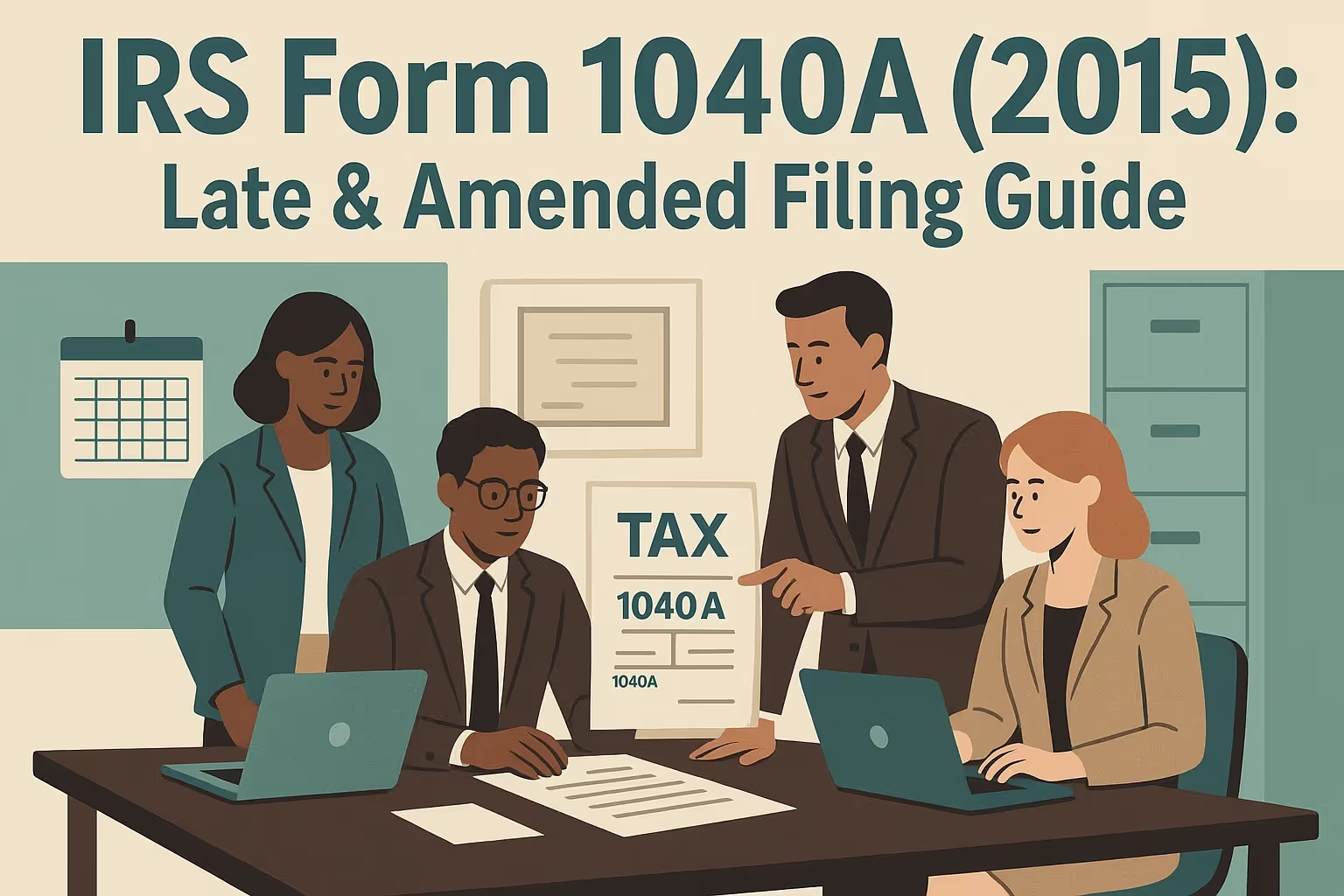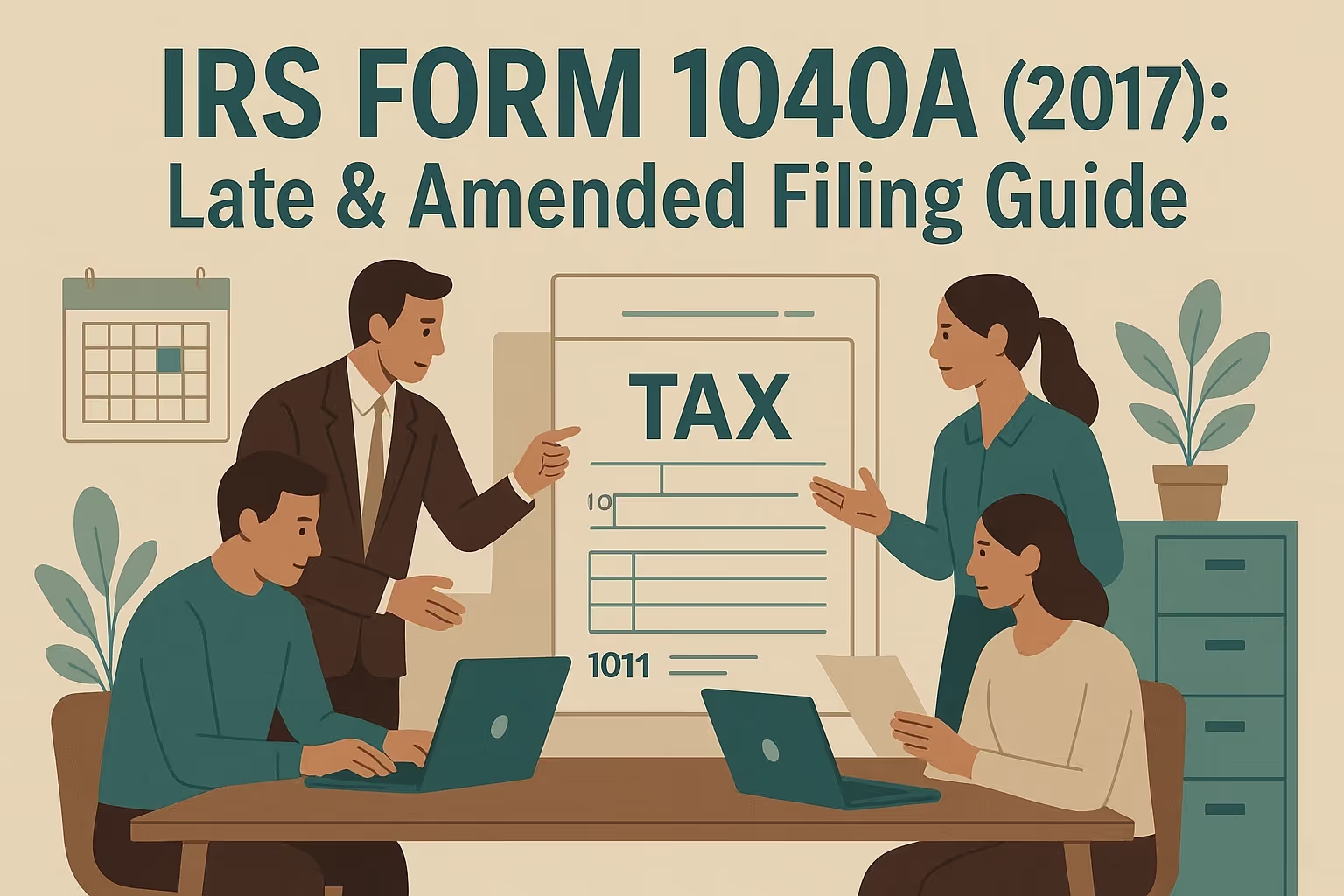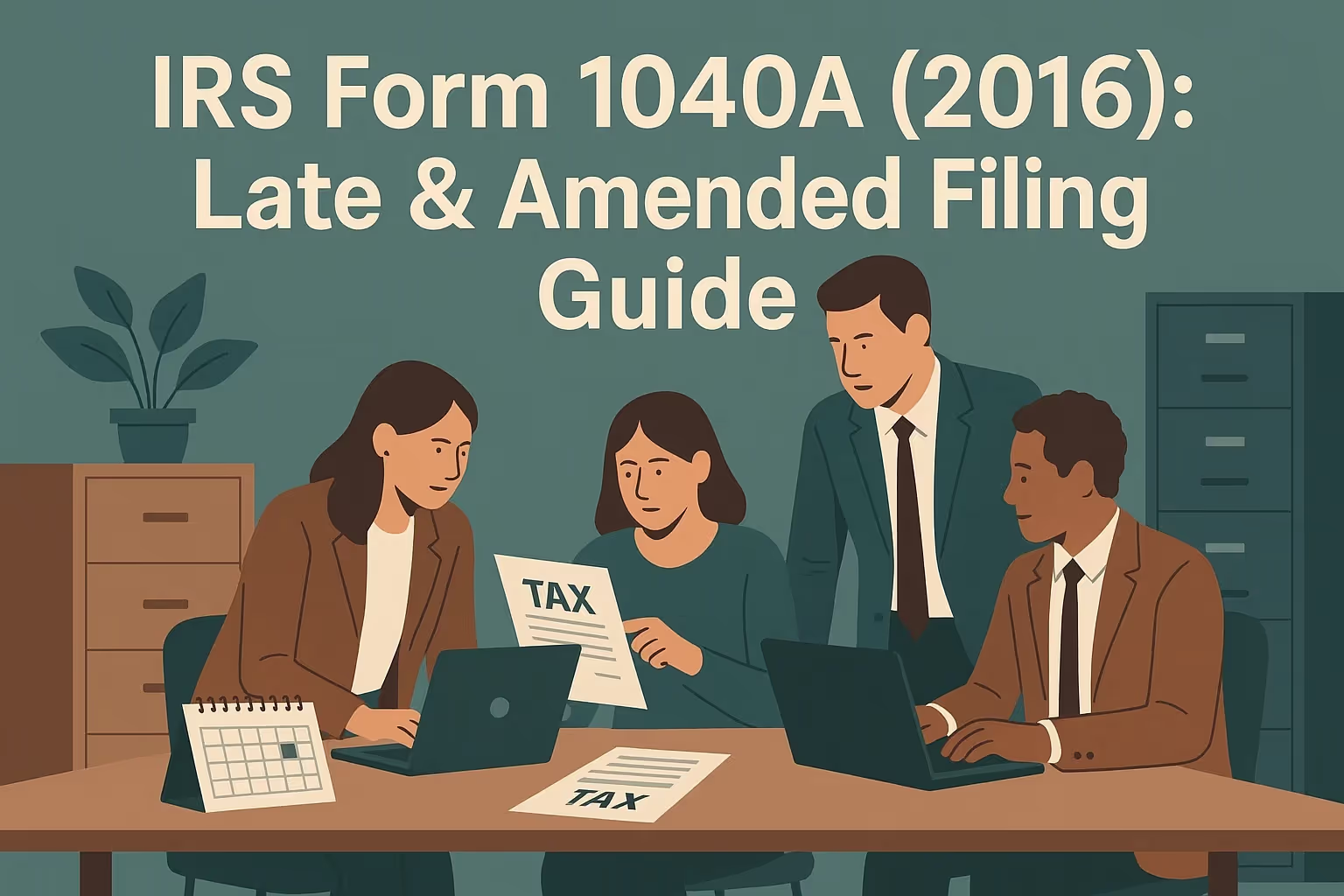How to File 2014 Form 1040A: Step-by-Step Tax Guide
Filing a federal tax return for tax year 2014 required choosing the correct form, and many taxpayers turned to Form 1040A. Often referred to as the “short form,” it provided a middle ground between the very simple 1040EZ and the more detailed Form 1040. For those with wages, dividends, retirement distributions, or Social Security income, Form 1040A offered a practical way to prepare and file without dealing with every schedule used in the long form.
This guide explains how to complete the instructions for Form 1040A 2014 clearly and step-by-step. It highlights what documents to gather, how to select a filing status, and the credits that could be claimed, such as the earned income tax credit or the child tax credit. While the IRS discontinued the form after several years, taxpayers can still file or amend a 2014 return, and the process remains essential for anyone reconciling past tax information. Understanding these details helps filers avoid errors and determine eligibility for deductions and other benefits.
Because the IRS recommends accuracy above all, careful preparation matters. Whether someone chooses to file with the help of a tax preparer, use software to complete their taxes online, or handle their own taxes directly, following proper guidance can save money and reduce hassle. With attention to detail and the right tools, taxpayers can confidently approach the 2014 Form 1040A filing process and aim for the maximum refund allowed.
What Is Form 1040A?
Form 1040A was a federal tax return option available to taxpayers with income and deductions that were more complex than Form 1040EZ allowed but simpler than the complete Form 1040. It provided a streamlined filing process while permitting necessary credits and specific adjustments. This form was applied to the 2014 tax year and served many filers who wanted to balance simplicity and flexibility.
Comparison with Other Forms
- Form 1040A vs. 1040EZ
Form 1040EZ was the simplest return, limited to wages, interest income, and a very narrow set of situations. Taxpayers who wanted to claim credits such as the earned income tax credit or child tax credit, or who had additional income like dividends or unemployment compensation, could not use Form 1040EZ. - Form 1040A vs. Form 1040
Form 1040 allowed the most deductions and schedules, making it necessary for complex situations such as self-employment, extensive investments, or itemized deductions. Taxpayers who filed Form 1040A avoided these extra schedules but reported a wider range of income and credits than those using the 1040EZ.
Key Benefits of Form 1040A
- It allowed reporting income sources such as wages, dividends, interest, unemployment compensation, and retirement distributions.
- It permitted the claim of valuable tax credits, including the earned income tax credit, child tax credit, and education credit.
- It offered a more straightforward process than the complete Form 1040, helping taxpayers determine eligibility for deductions.
- It could be filed electronically, allowing filers to e-file and receive faster refunds.
- It provided an accessible option for individuals who wanted to prepare their taxes without relying entirely on a tax preparer.
Form 1040A gave taxpayers a middle ground between limited and comprehensive filing. Balancing simplicity with flexibility was a helpful option for millions of filers who wanted to complete their taxes accurately while taking advantage of credits and deductions.
Key Changes for Tax Year 2014
The 2014 tax year introduced several updates that directly affected Form 1040A filers. These changes included health care coverage requirements under the Affordable Care Act, new rules for the premium tax credit, and adjustments to exemptions and deductions. Understanding these updates is essential to ensure accuracy when preparing a federal tax return.
Affordable Care Act Requirements
- Coverage reporting was added to line 38 of Form 1040A. Taxpayers were required to indicate whether they, their spouse, and their dependents had qualifying health insurance for the entire year.
- Taxpayers who did not have coverage for all of 2014 could apply for an exemption by completing Form 8965. This form helped eligible individuals avoid paying the shared responsibility penalty.
- Those who did not have qualifying coverage and did not meet the exemption rules had to pay the shared responsibility payment. The amount owed was based on income level and the number of household members.
Premium Tax Credit
- Individuals who purchased health insurance through the Marketplace received Form 1095-A. This form lists monthly premiums and any advance payments made on their behalf.
- Taxpayers who received advance payments were required to complete Form 8962. This step ensured the credit was reconciled with actual eligibility, preventing overpayment or underpayment of the premium tax credit.
Other 2014 Adjustments
- The personal exemption increased to $3,950 for 2014, slightly higher than the previous year.
- Standard deduction amounts were adjusted to account for inflation, giving taxpayers slightly higher deductions.
- The IRS limited the number of refunds deposited into a single financial institution account to three, a measure intended to reduce fraud.
- Certain Medicaid waiver payments for home care were now excluded from income, allowing some taxpayers lower taxable incomes.
These changes meant taxpayers must carefully review their tax information, gather the correct forms, and apply the updated rules when completing Form 1040A 2014 instructions.
Step-by-Step Filing Instructions
Completing Form 1040A required careful preparation and organization. Following a structured process helped filers avoid errors, ensure accuracy, and potentially maximize a refund.
Before You Begin: Gather Documents
- Taxpayers needed W-2 forms from each employer, which reported wages earned and taxes withheld during the year.
- Interest and dividend income had to be reported using 1099-INT and 1099-DIV forms issued by financial institutions.
- Retirement distributions were documented using 1099-R forms, while unemployment compensation appeared on Form 1099-G.
- Taxpayers who purchased Marketplace insurance received Form 1095-A, which confirmed coverage and advance premium tax credits.
- Social Security cards were required for the taxpayer, spouse, and dependents to ensure accurate reporting of Social Security numbers.
- Receipts were needed for deductible expenses such as student loan interest or educator supplies, which could reduce taxable income.
- Bank account and routing numbers were necessary for anyone who wanted to use direct deposit for a faster refund.
Having complete tax information at the start reduced errors and ensured that the return could be filed without unnecessary delays.
Personal Information and Filing Status
Lines 1 through 6 required names, addresses, and Social Security numbers. Choosing a filing status determined the standard deduction, tax brackets, and eligibility for specific credits. Options included single, married filing jointly, married filing separately, head of household, and qualifying widow(er). Filing status helped taxpayers determine their liability and eligibility for credits such as the earned income tax credit.
Claiming Exemptions
Form 1040A allowed personal and dependency exemptions, each reducing taxable income by $3,950 in 2014. Dependents had to meet relationship, age, residency, and support requirements. Taxpayers could also claim exemptions for certain relatives who met IRS rules.
Reporting Income
Line 7 covered wages, salaries, and tips reported on W-2 forms. Other income sources, such as interest, dividends, unemployment benefits, retirement distributions, and Social Security payments, were reported separately. Since the IRS received income information directly from employers and financial institutions, taxpayers needed to ensure all amounts were included on the return.
Adjusted Gross Income
Lines 16 through 21 included deductions that reduced adjusted gross income. Examples included educator expenses, student loan interest, and contributions to a traditional IRA.
Adjusted gross income determined whether taxpayers were eligible for valuable credits such as the child and earned income tax credit. By following these instructions, filers could prepare their federal tax return accurately and minimize the chance of errors or delays.
Filing Methods for 2014 Form 1040A
Once Form 1040A was completed, taxpayers had to decide how to file. The Internal Revenue Service recommended electronic filing because it was faster, safer, and more efficient, but paper filing was still available.
Electronic Filing
- Taxpayers who met income requirements could e-file using IRS Free File software or choose fillable online forms if they preferred to enter tax information.
- Electronic filing offered many benefits, including quicker refunds, instant confirmation that the IRS received the return, and fewer mistakes because the software flagged possible errors.
- Security was emphasized during electronic filing. The IRS advised taxpayers to look for the locked padlock icon in their browser, use a secure device, and file only through trusted services.
Paper Filing
- Paper filing required careful preparation, including using black ink, rounding figures to whole dollars, and properly completing required forms and schedules. The forms and schedules needed depended on the taxpayer’s state of residence and whether a payment was enclosed with the return.
- Processing time for paper returns was significantly longer, often taking six to eight weeks, compared to about three weeks for electronically filed returns.
Choosing between electronic and paper filing depended on individual needs, preferences, and comfort level with technology. However, most taxpayers found that electronic filing through reliable software or with the help of a tax preparer was more efficient and reassuring.
Payment and Refund Options
Form 1040A filers for tax year 2014 needed to plan for paying additional tax or receiving a refund. The IRS recommended filing early to avoid delays and using electronic payment and refund systems for speed and accuracy.
If You Owe Tax
- Taxpayers could pay directly using IRS Direct Pay, which securely transferred money from a bank account to the Treasury.
- Another option was the Electronic Federal Tax Payment System (EFTPS), which allowed online or phone payments through a financial institution account.
- Payments can also be made with a credit or debit card through IRS-authorized processors, although service fees apply.
- Checks or money orders were accepted when mailed with Form 1040V, and taxpayers had to write their Social Security number and tax year on the payment.
Installment Agreements
- Short-term payment plans allowed up to 120 days to pay the full amount, usually with little or no setup fee.
- Long-term installment agreements spread the balance over monthly payments, though setup costs were higher.
- Taxpayers who could not pay in full were encouraged to apply promptly to avoid penalties and interest that increased the amount owed.
If You Expect a Refund
- Direct deposit was the fastest way to receive a refund, with money deposited directly into a bank account.
- Refunds could also be mailed as paper checks, though processing took longer.
- The IRS limited deposits to three refunds per account each year to reduce fraud.
Planning for payment or refund ensured taxpayers avoided mistakes, met the due date, and managed money responsibly.
Required Attachments and Schedules
Form 1040A sometimes requires additional forms to support credits or exemptions. Taxpayers correct documents to avoid errors and delays. To prevent the mistakes and delays
Mandatory Attachments
- Form 8962 was required for taxpayers who received advance premium tax credits through the Marketplace. It reconciled payments with the amount actually allowed.
- Form 8965 was necessary for those claiming health coverage exemptions. This form prevented the shared responsibility payment if the exemption applied.
- Schedule EIC was required if a taxpayer claimed the earned income tax credit and had qualifying children.
Common Additional Forms
- Form 2441 was used to claim the Child and Dependent Care Credit, which helped offset the cost of child care.
- Form 8863 allowed taxpayers to claim education credits, such as the American Opportunity Credit or Lifetime Learning Credit.
- Schedule R applies to the credit for the Elderly or Disabled, available to qualifying filers.
- Form 8880 provided the Retirement Savings Contributions Credit for those making eligible contributions.
Attachment Guidelines
- Taxpayers were instructed to attach all forms in the order listed behind Form 1040A.
- Copies of all forms and receipts needed to be kept for personal records.
- Paper returns require forms to be clipped together securely, not stapled.
Completing the federal tax return with the correct attachments helped filers claim credits properly, maintain accuracy, and avoid IRS contact requesting missing documents.
Common Mistakes to Avoid
Mistakes on Form 1040A could delay refunds or increase the amount owed. The IRS encouraged taxpayers to review their returns carefully and use e-file whenever possible to reduce errors.
- Mathematical errors were frequent, especially with addition and subtraction. Taxpayers were urged to double-check all calculations or rely on tax software for accuracy.
- Incorrect or missing Social Security numbers caused delays in processing and sometimes led to rejected returns. Each SSN had to match the name on the Social Security card exactly.
- Choosing the wrong filing status can change eligibility for deductions and credits, so taxpayers must determine their situation carefully.
- Omitting income was another common issue. Since the IRS already had copies of W-2s and 1099s from employers and financial institutions, missing income often triggered notices.
- Forgetting to sign and date the return invalidated the filing. When filing jointly, both spouses had to sign unless one had a valid power of attorney.
By reviewing tax information carefully, keeping receipts, and using tools such as tax software or expert help, taxpayers could file more accurately and avoid unnecessary corrections.
Special Situations and Tips
Not every taxpayer had a straightforward return in tax year 2014. Some faced exceptional circumstances that required extra care when preparing Form 1040A. Knowing these situations helped filers determine whether they were eligible to use the form and how to prepare their federal tax return correctly.
Filing With No or Minimal Income
- Taxpayers with little or no income sometimes still needed to file. Filing could allow them to claim refundable credits, such as the earned income tax credit or the additional child tax credit.
- Even if they earned below the filing threshold, those with taxes withheld from wages often filed to receive a refund of the already paid money.
- Filing also created an official record with the IRS, which could help apply for future benefits or loans through a financial institution.
First-Time Filers
- Before beginning, individuals filing their taxes for the first time must gather all documents, such as W-2s, receipts, and bank details.
- When e-filing, first-time filers used their date of birth instead of prior-year information.
- Accuracy was critical, as mistakes could delay a refund or require contact with the IRS for corrections.
Reasons to File Even if Not Required
- Filing allowed taxpayers to recover withheld income tax or claim credits that provided a refund.
- Filing started the statute of limitations, which protected the filer from the IRS questioning the return after several years.
- A complete return could also provide reassurance and proper documentation for state programs or financial services.
By paying attention to these special situations, taxpayers reduce the chance of errors, claim money they are entitled to, and gain peace of mind about their tax filing.
Frequently Asked Questions
What are the instructions for Form 1040A 2014, and who can use them?
The Form 1040A 2014 instructions guide taxpayers with moderate income when filing a federal tax return. Filers who earned wages, interest, or retirement income and wanted to claim tax credits such as the earned income tax credit or child tax credit were eligible to use this form. It offered a more straightforward process than Form 1040, helping taxpayers prepare their taxes with fewer forms while ensuring accuracy.
How do I choose the correct filing status for my tax return?
Filing status determined the deductions, credits, and tax rates applied to a federal tax return. Taxpayers could select single, married filing jointly, married filing separately, head of household, or qualifying widow(er). The IRS recommends reviewing each option carefully to determine eligibility and avoid mistakes. Choosing the right filing status ensured the return was correct, supported the claim of credits, and often helped filers achieve the maximum refund.
Can I still e-file my 2014 tax return?
The IRS does not allow direct e-file submission for prior years, including the 2014 tax year. Taxpayers must instead print and mail completed forms to the appropriate IRS address. However, software tools can still prepare taxes online, generate accurate documents, and produce forms for mailing. Using secure devices, looking for the locked padlock icon, and keeping receipts ensured accuracy and reassured filers that their tax information remained safe.
What if I owe taxes after completing my return?
The IRS provides several payment options if taxpayers determine they owe taxes for the 2014 tax year. Money can be paid directly from a bank account through IRS Direct Pay or through a financial institution using EFTPS. Credit and debit card payments are also accepted, though fees may apply. To avoid penalties and interest in future years, the IRS recommends applying for an installment agreement if unable to pay in full by the due date.
Should I use a tax preparer or handle my own taxes online?
Taxpayers can prepare their taxes online using free IRS tools or software or work with a tax preparer or expert for guidance. Those filing for the first time may find expert help reassuring, while others prefer completing forms directly to save money. Either option allows filers to claim credits, upload tax information, and ensure accuracy, but expert help may reduce errors and hassle in the process.













